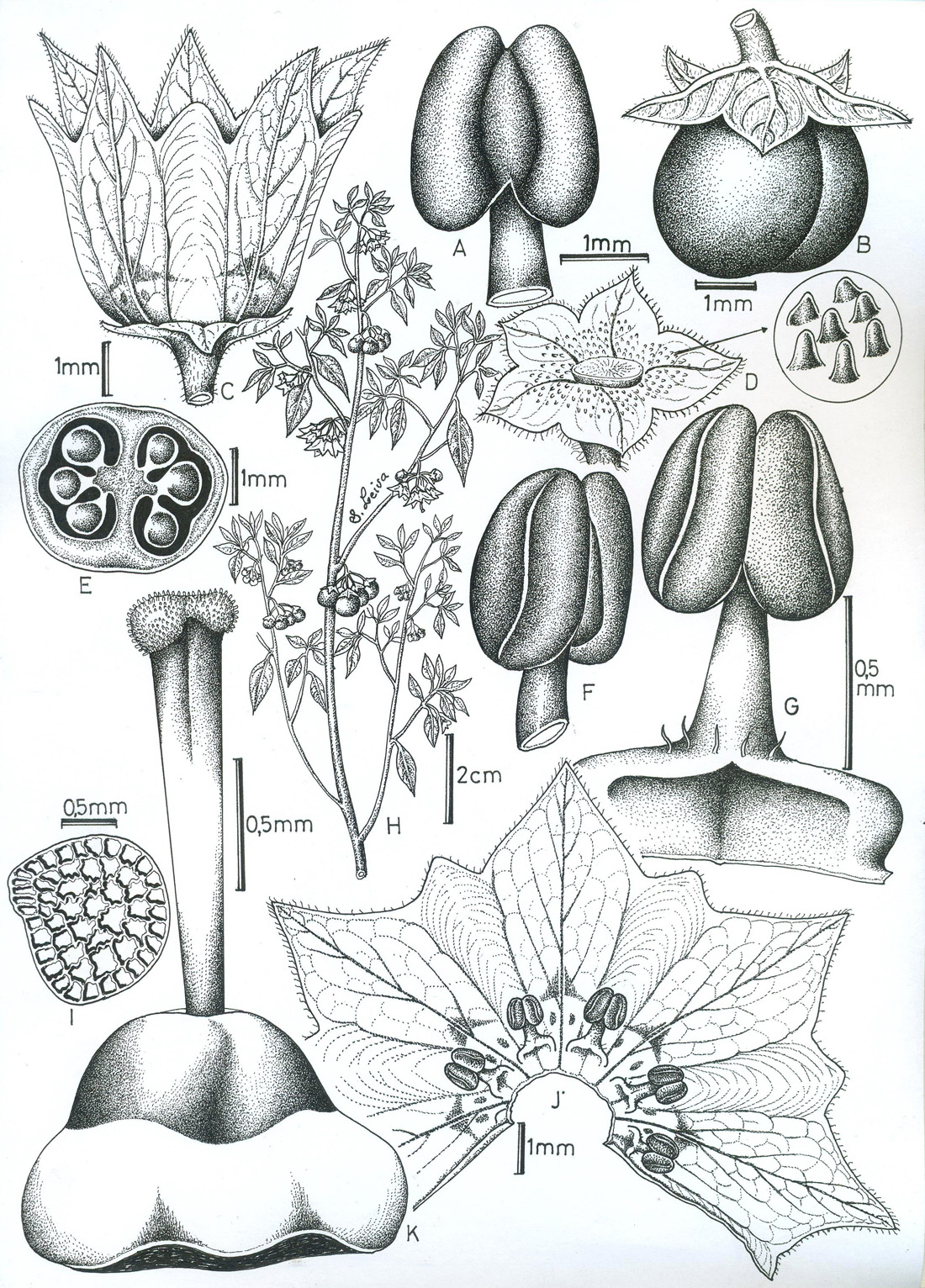
Jaltomata pauciseminata S. Leiva & Mione |
Peru |
revised 4 Feb 2022 |
| Link to Jaltomata homepage | The information on this page may be cited as a communication with professor Thomas Mione, Central Connecticut State University, Biology Department, Copernicus Hall, 1615 Stanley Street, New Britain, Connecticut 06050-4010, United States of America. |
Link to the Jaltomata of Peru's departmentLa Libertad |
Link to the Jaltomata of northern Peru |
| Figure 1.Branches, leaves, inflorescences and unripe fruits of Jaltomata pauciseminata (Mione et al. 824, photo by Segundo Leiva G.). |
| Figure 2. Leaves and flower in side-view of Jaltomata pauciseminata (units are mm, Mione et al. 824, photo by Thomas Mione). |
| Figure 3. Branches, leaves and immature fruit of Jaltomata pauciseminata. Numbered units are cm. Mione et al. 824, photo by Thomas Mione. |
 |
| Figure 4. Jaltomata pauciseminata. Illustration by Segundo Leiva G. |
The flowers of the 2013 collection were all male-sterile, it seems from photos. To do: Look back at preserved material from 1999 collection and see if flowers were male-sterile (comment of 13 July 2013). This species is very hard to find. It grows in remant patches of native vegetation, and even when you find such a patch you can look for this species and not see it. In other words, even eyes that are highly trained to spot the genus Jaltomata can, at times, not detect this species! Shrub; leaf blades to 2.7 cm long; inflorescence 6–10 flowered; corolla whitish, crateriform, with 10 green maculae in throat and a purple ring fading in intensity proximal to distal, 5 – 7 mm in diameter, 10-lobed, the lobes and lobules alternating; the stamens very short, included, purple where the filaments meet their expanded bases. |
| Figure 5. Jaltomata pauciseminata. Numbered units on left side of the ruler are cm. Mione et al. 824, photo by Thomas Mione. |
| Figure 6. Numbered units on left side of the ruler are cm, Mione et al. 824, photo by Thomas Mione |
| Figure 7. Numbered units on the side of the ruler closest to the viewer are cm, Mione et al. 824, photo by Segundo Leiva G. |
| Figure 8. Ovarian disk is bright orange; stamens look sterile; fruits are unripe. Mione et al. 824, photo by Segundo Leiva G. |
| Figure 9. Stamens look sterile; fruits are unripe; flower bud at bottom near center. Units on left are mm, Mione et al. 824, photo by Thomas Mione |
| Figure 10. Mione et al. 824, photo by Segundo Leiva G. |
| Locality | elevation |
habitat |
date |
collector (herbarium) |
| Roadside, S 08 07.948, W 78 04.845 | 3232 m |
partial shade of trees, closely surrounded by other shrubs | 25 Mar 2013 |
TYPE SPECIMEN Leiva, Yacher & Mione 5418 Holotype: HAO |
| Roadside, S 08 07.948, W 78 04.845, very difficult to find even to a trained eye! | 3232 m |
partial shade of trees, closely surrounded by other shrubs | 25 Mar 2013 |
collected at same place and time as type specimen: Mione, Yacher & Leiva 824 |
| Cachicadán, at source of thermal waters (Not found at this location when we looked again in 2013). |
3050 m |
in a remnant patch of native vegetation in an otherwise cut-over area, partial shade | 13 June 1999 |
Leiva, Yacher & Mione 2338 Mione, Yacher & Leiva 644 |
| Figure 11. Stamens of Jaltomata pauciseminata look sterile. Mione et al. 824, photo by Thomas Mione |
Figure 12 Stamens of J. pauciseminata appear to be sterile. Units in lower left corner are mm, Mione et al. 824, photo by Thomas Mione |
| Figure 13. Jaltomata pauciseminata. Smallest units are mm, Mione et al. 824, photo by Thomas Mione. | Figure 14. Jaltomata yungayensis for comparison (Mione et al. 825). Note that the leaves and fruits are larger than those of J. pauciseminata. The smallest units are mm; the numbered units are cm. |
 |
Figure 15.
Mione et al. 644
A print was scanned. |
Figure 16. Jaltomata pauciseminata. Mione et al. 824 |